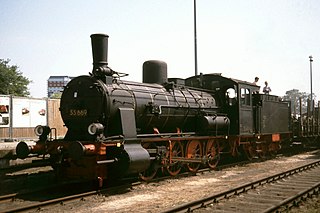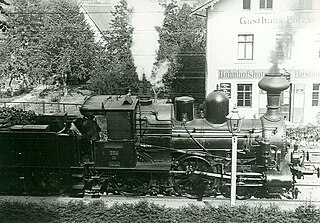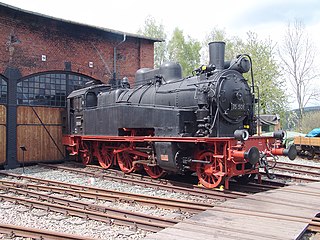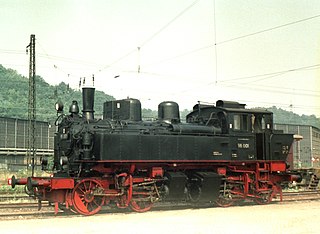Class D I of the Royal Bavarian State Railways was a tank locomotive with two coupled axles designed for shunting. As had been specified, these locomotives were simple and robust. They had a double-frame, with water tanks being suspended between the sole bars of the front section. Because the water capacity of 1.74 m3 soon proved too little even for a shunter operating only within the limits of its own station, additional side tanks were added to some engines during the 1880s. The outside Stephenson valve gear moved the valves on top of the horizontal cylinders. The locomotives could be braked using an Exter counterweight brake.
The Bavarian Class D IV was a German steam locomotive with the Bavarian Eastern Railway.
The Mecklenburg T 3 was a German, goods train, tank locomotive built for the Grand Duchy of Mecklenburg Friedrich-Franz Railway from 1884. Originally designated as the Class XVII it had an 0-6-0T wheel arrangement and was based on the Prussian T 3.
The Oldenburg G 4.2 steam locomotives were goods train engines built for the Grand Duchy of Oldenburg State Railways between 1895 and 1909 in several series.

The Oldenburg G 7 steam locomotive was a German 0-8-0 locomotive produced for the Grand Duchy of Oldenburg State Railways. It was an eight-coupled engine, intended for heavy goods train duties, and was based on the Prussian G 7. It had a 1,660 mm diameter boiler located 2,820 mm above the top of the rails in the plate frame, and was equipped with a single Walschaerts valve gear as well as a Lentz valve gear. Thirteen were taken over by the Deutsche Reichsbahn, grouped into DRG Class 55.62 and given numbers 55 6201–55 6213.
The Saxon Class XVIII was a German six-coupled tender locomotive built for the Royal Saxon State Railways in 1917/18 for express train services. The Deutsche Reichsbahn grouped them in 1925 into DRG Class 18.0.
The Saxon Class IX was a class of German, eight-coupled, tender locomotives built for the Royal Saxon State Railways for goods train duties.

The Saxon Class III b were German steam locomotives built for the Royal Saxon State Railways in the late 19th century as tender locomotives for express train duties. In 1925, the Deutsche Reichsbahn incorporated the engines into DRG Class 34.77-78.

In 1905 the Prussian state railways grouped six-coupled, medium-powered, goods train, tank locomotives into its Class G 3. In addition to standard locomotives, there were also 285 G 3s that were not built to German state railway norms, because they had been built, in most cases, before the foundation of the Prussian state railways.

The Saxon Class VIb were four-coupled, tender locomotives in express train service with the Royal Saxon State Railways. In 1925, the Deutsche Reichsbahn grouped these engines into DRG Class 34.8.

The Saxon Class XIV T locomotives were six-coupled tank engines operated by the Royal Saxon State Railways for mixed duties on main and branch lines. In 1925, the Deutsche Reichsbahn grouped them into their DRG Class 75.5.

The Saxon Class XV HTV was a class of goods train steam locomotive operated by the Royal Saxon State Railways, which had been conceived for hauling trains and acting as banking engines for routes in the Ore Mountains. In 1925 the Deutsche Reichsbahn grouped them into their DRG Class 79.0.

The Saxon Class V K were German 0-8-0T narrow gauge steam locomotives operated by the Royal Saxon State Railways which had been primarily intended for the Müglitztalbahn. In 1925 the Deutsche Reichsbahn incorporated arranged these locomotives as DRG Class 99.61.
The Royal Saxon State Railways designated four-coupled, Atlantic (4-4-2) express locomotives as Class X and the Deutsche Reichsbahn subsequently grouped these locomotives into DRG Class 14.2 in 1925.
The Mecklenburg Class G 3 was an early German steam locomotive operated by the Grand Duchy of Mecklenburg Friedrich-Franz Railway. Formerly the Class IX it was a copy of the Prussian G 3.
The Mecklenburg Class G 4.2 operated by the Grand Duchy of Mecklenburg Friedrich-Franz Railway was a goods train, steam locomotive with a compound engine. It was procured between 1901 and 1905 from Henschel and Linke based on the Prussian G 4.2 prototype. A total of five machines were built for Mecklenburg. It was planned that they would be taken over by the Deutsche Reichsbahn and were to have been given numbers 53 401 to 53 405 according to the 1923 provisional DRG renumbering plan. But they were retired by 1924 before the final plan was issued.

The Saxon Class IIIb was a twin-coupled tender locomotive built for passenger services with the Royal Saxon State Railways.

The Saxon Class V was a triple-coupled, goods train, tender locomotive operated by the Royal Saxon State Railways. In 1925, the Deutsche Reichsbahn regrouped the locomotives 25 into their DRG Class 53.6–7.

The Saxon class I T were a class of 19 German 0-4-4-0 Meyer tank locomotives built for the Royal Saxon State Railways for service of the Windbergbahn. The Deutsche Reichsbahn assigned them to Class 98.0.
The Prussian G 4.2 was a class of compound 0-6-0 goods locomotive of the Prussian State Railways. It was a compound version of the G 3 and G 4.1 types by Henschel.










